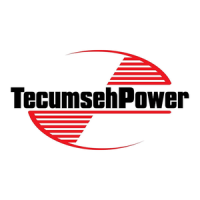
Do you have a question about the Tecumseh TM049XA (TC300) and is the answer not in the manual?
| Displacement | 49 cc |
|---|---|
| Power Output | 1.5 HP |
| Fuel Type | Gasoline |
| Cooling System | Air-cooled |
| Max RPM | 3600 RPM |
| Ignition System | Electronic |
| Starter Type | Recoil |
| Carburetor | Diaphragm |
| Shaft Size | 3/4" |
| Engine Type | 4-stroke, single cylinder |
Engine exhaust contains deadly carbon monoxide gas. Avoid poisoning.
Gasoline vapors are flammable and can explode. Prevent fuel fires.
Ensure adults supervise engine operation, refueling, and maintenance.
Keep hands, feet, and clothing away from rotating engine parts.
Do not modify the engine governor setting, as it can cause unsafe speeds.
Engine parts become extremely hot. Avoid burns and fire hazards.
Disconnect spark plug wire and take precautions to prevent accidental starts.
Engine noise can cause hearing damage. Always wear hearing protection.
Locate and record engine model, type, specification, and date of manufacture.
Technician's Handbooks are available for those who wish to perform repairs.
Use clean, high-quality 2-cycle oil mixed with fuel at a 24:1 ratio.
Use unleaded regular, premium, or reformulated automotive fuel only.
Mix fuel and oil in a well-ventilated area using approved containers.
Ensure adult supervision when fueling and follow safety precautions.
Check ignition switch, compression relief valve, and fuel cap air vent.
Remove dirt and debris from cooling fins, air intake screen, and levers.
Clean muffler and cylinder exhaust ports every 50 hours of operation.
Check spark plug yearly or every 50 operating hours for wear or fouling.
Instructions for cleaning and replacing air filters to maintain engine performance.
Steps for removing, cleaning, and installing air filters and covers.
How to clean and re-oil foam filters every 3 months or 25 operating hours.
Procedure for cleaning flocked screens using water and detergent.
Refer to equipment manufacturer for remote choke operation and service.
Contact an Authorized Tecumseh Servicing Dealer for carburetor adjustments.
Do not modify engine speed governor settings to avoid unsafe operation.
Factory settings are satisfactory; contact dealer for any adjustments.
See equipment manufacturer's instructions for proper battery storage.
Prepare engine for short-term storage by cleaning and treating fuel.
Clean engine by removing debris from cooling fins, levers, and guards.
Store engine with fuel in a well-ventilated area away from ignition sources.
Prepare engine for extended storage by treating fuel or draining tank.
Empty fuel tank by running engine until it stops from lack of fuel.
Explains warranty coverage for emission control systems on new engines.
Owner is responsible for required maintenance and proper use of the engine.